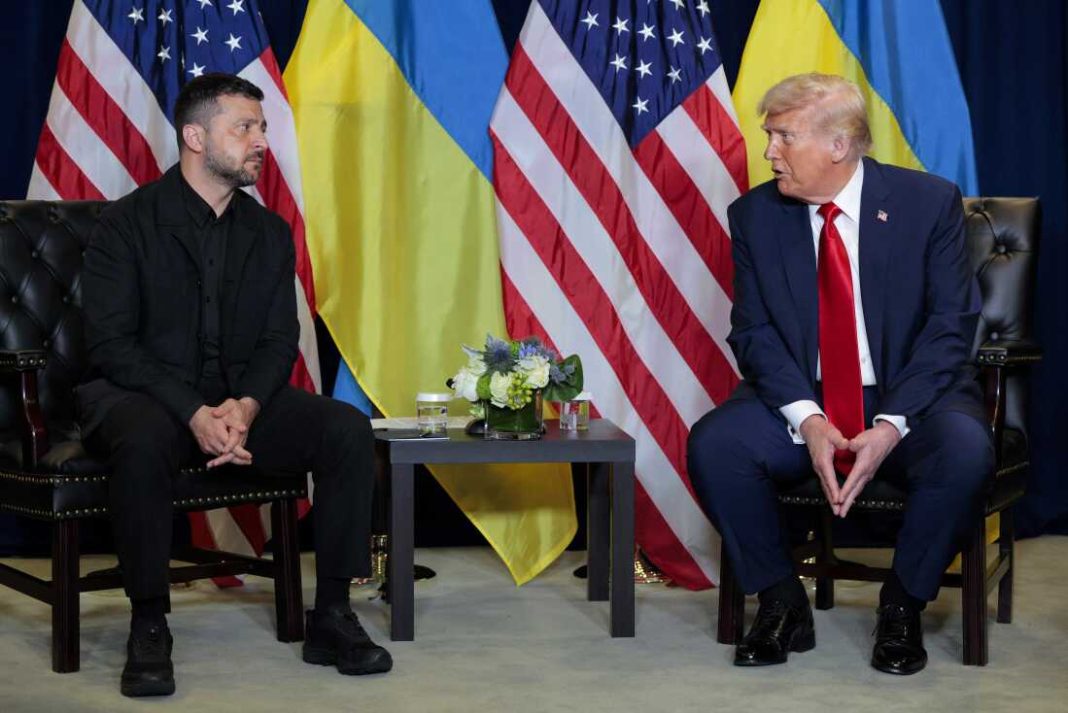On Friday, President Donald Trump met with Ukrainian President Volodymyr Zelenskyy at the White House. Soon after the meeting, Trump made a statement that stunned many observers worldwide. He suggested that Russia should be allowed to keep the seized Ukrainian land it has captured since Russia’s invasion nearly four years ago.
Trump’s Controversial Proposal on Seized Ukrainian Land
In a social media post about 45 minutes after Zelenskyy left the White House, Trump wrote, “It is time to stop the killing, and make a DEAL! Enough blood has been shed, with property lines being defined by War and Guts. They should stop where they are. Let both claim Victory, let History decide! No more shooting, no more Death, no more vast and unsustainable sums of money spent. This is a War that would have never started if I were President. Thousands of people being slaughtered each and every week — NO MORE, GO HOME TO YOUR FAMILIES IN PEACE!”
Later, upon landing in Florida, where he planned to spend the weekend at his Palm Beach country club, Trump reinforced this idea. He told reporters, “Go by the battle line wherever it is or else it gets too complicated. Stop right now at the battle line.”
Zelenskyy and Trump Eye Critical Meeting Amid War and Resource Talks
It is unclear whether this represents a new policy or is another spontaneous remark, as Trump has a history of sudden statements. This time, his comments focused on formalizing the status of seized Ukrainian land.
Trump’s Past and Current Views on Russia and Seized Ukrainian Land
Trump has a long and controversial history regarding Russia and Ukraine. In early 2022, shortly after Putin invaded Ukraine, Trump praised the Russian president, calling him a “genius” and “savvy” for sending troops to seize Ukrainian territory. Over time, Trump shifted blame for the invasion, criticizing Zelenskyy for failing to prevent the war and former President Joe Biden for letting it happen. Only recently has he publicly criticized Putin for attacks on civilians, especially drone and missile strikes targeting Ukrainian cities.
The White House meeting on Friday came a day after Trump reportedly spoke with Putin for two hours on the phone. During that call, he claimed the two leaders made “great progress” toward ending the war. One major topic was the possible transfer of U.S. Tomahawk missiles to Ukraine, capable of striking deep into Russian territory. Trump expressed concerns, asking, “What’s going to happen if the United States is in a conflict and we need the Tomahawks? That’s the problem. We need Tomahawks.”
Ukraine imposes sanctions on 62 for stealing resources and heritage from occupied lands
Despite criticism of recent attacks, Trump continues to emphasize his “good relationship” with Putin. He cited it as a reason for inviting Putin to Alaska in August and reportedly rolled out a red carpet during the visit. Nevertheless, Russia resumed attacks on Ukrainian cities after that meeting, despite Trump expecting a ceasefire. His remarks on seized Ukrainian land reflect his ongoing focus on ending the conflict quickly.
Zelenskyy’s Response and Meeting Dynamics
During the White House meeting, Zelenskyy avoided confrontation and praised Trump for his achievements, including a successful ceasefire in the Middle East. Zelenskyy’s strategy mirrors tactics used by other U.S. allies to maintain positive relations with Trump.
The Ukrainian president also wore a formal blazer and tie for the meeting, avoiding the military fatigues he had worn in February. On that earlier visit, Trump and Vice President JD Vance had criticized Zelenskyy for not appearing sufficiently grateful. European observers widely criticized that encounter.
In his remarks, Trump expressed surprise at the ongoing conflict between Zelenskyy and Putin. “There’s a lot of bad blood with the two presidents,” he said. “These two leaders do not like each other.”
Meanwhile, Putin continues to face widespread international condemnation. His attacks on civilians in Ukraine have been labeled war crimes by the International Criminal Court. The frequency of attacks reportedly increased after Trump returned to office, according to BBC analysis.
Trump also suggested meeting Putin again in Budapest, Hungary. The city is notable because Hungary’s leader, Viktor Orbán, is considered one of the few pro-Putin figures in NATO. Budapest was also the site where Russia promised in 1994 not to invade Ukraine if it gave up nuclear weapons inherited from the Soviet Union.
Throughout all these discussions, Trump’s repeated focus on seized Ukrainian land shows it remains a central point in his view of resolving the war.
